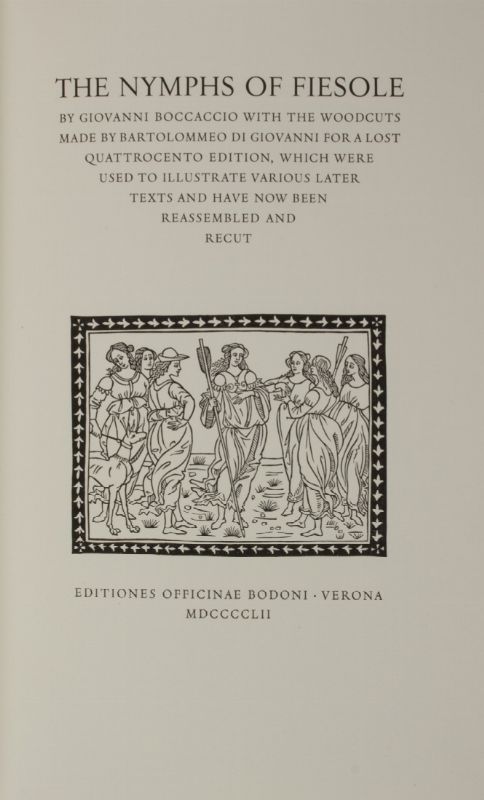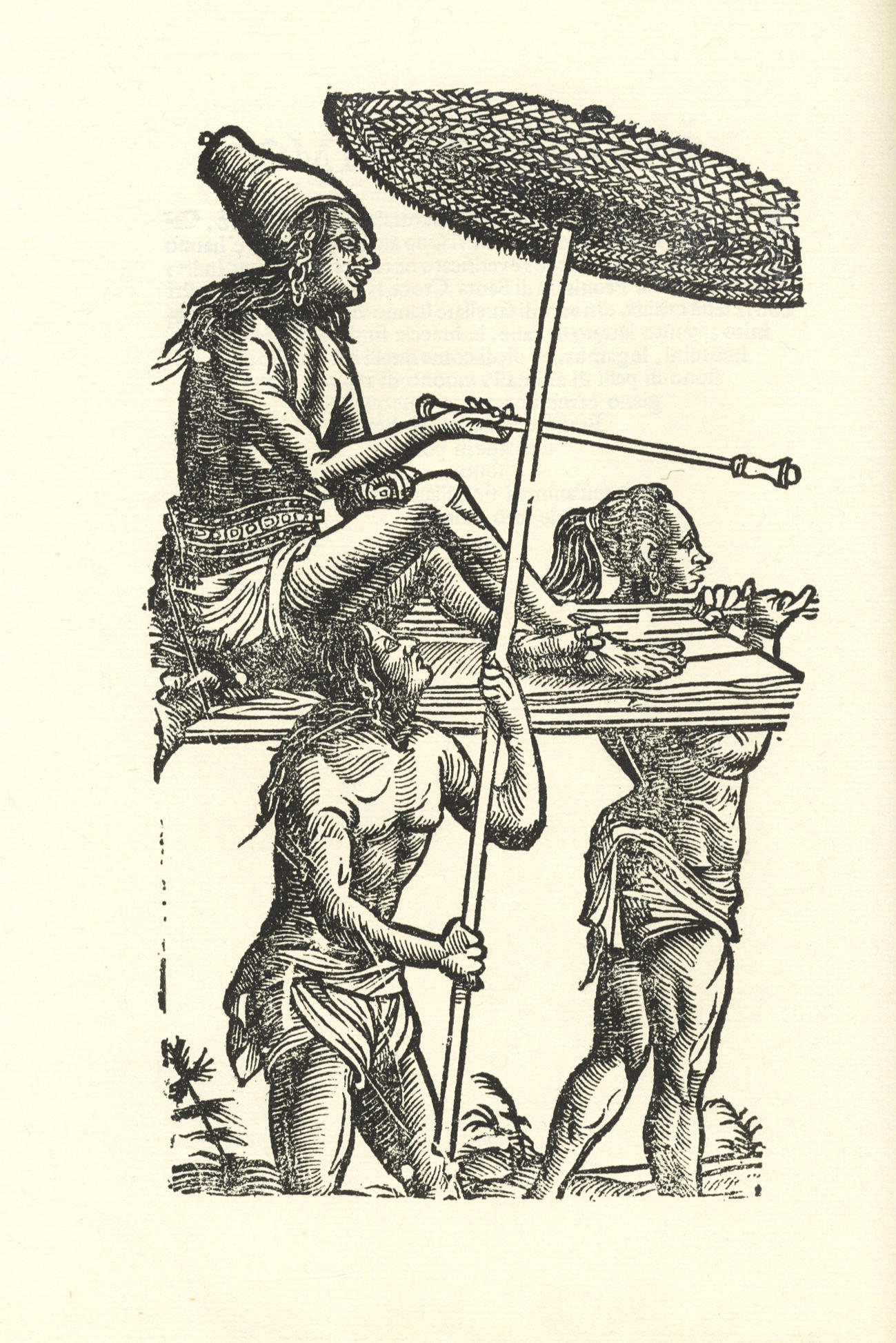BOCCACCIO, Giovanni (1313-1375). Il Ninfale Fiesolano : ANDREA DA BARBERINO (1370-ca 1431). Stanza per una schermaglia , in Italian, DECORATED MANUSCRIPT ON PAPER [Florence, ?2nd quarter 15th century] Chancery 4° (215 x 145mm). 99 leaves: 1-5 10 , 6 9 (of 10, v cancelled blank), 7 10 , COMPLETE including 15 blank folios at end, gathering 1 numbered in lower margin of final verso and gatherings 2-9 on final verso (9 numbered 8), modern pencil foliation, 24 lines written in brown ink in a gothic mercantile cursive hand between two bounding verticals and two bounding horizontals ruled in brown ink, justification: 150 x 90mm, LARGE DECORATED INITIAL with blue skeletal staves and flourishing of red and blue penwork, display capitals of red and blue with contrast flourishing (folios at front and back slightly wormed, rodent damage to first folio, some spotting of margins). 15th-century panelled goatskin stamped in blind (restored, upper joint cracked, split at foot). PROVENANCE: Prince Piero Ginori Conti (bookplate). CONTENTS: ff.1-80v, Boccaccio's Il Ninfale Fiesolano ; ff.81-84, Andrea de Barberino, Stanza per una schermaglia The Ninfale Fiesolano belongs to the period immediately before Boccaccio wrote the Decameron when family circumstances had caused him to be summoned back to Florence from Naples. The poem is set in the Tuscan countryside and has a mythical theme reminiscent of Ovid -- the two ill-starred lovers turn into streams. It is clear that the Maestro Andrea identified as the author in the title of the Stanze that open on f.81 refers to Andrea di Jacopo de' Mengabotti da Barberino, who was one of the most popular versifiers and performers to render French chivalric romances into Tuscan; precise stylistic analogies can be made between this Stanza per una schermaglia and his Reali di Francia and Rinaldo da Montalbano . The contest that is the subject of Maestro Andrea's verses took place in the Piazza de' Signori in January 1419; from the title the verses appear to have been written in 1423. This is an unpublished work of one of the most noted representatives of 15th-century popular literature. The sporting event it records involved various combatants taking turns to spar on a purpose-built platform; the author compares the strong youths to heroes of antiquity, and the onlooking women, splendidly dressed and lined up in the windows and balconies facing the piazza, he compares with famous women of antiquity. Such games were part of the emphasis on physical culture in 15th-century Florence, which was later endorsed by Palmieri; he wrote 'For the exercise of the body, young men are praised for arms practice, hand-to-hand fighting, jousts, horse-riding and any sort of agility test'. It was Alberti's opinion that 'almost no game where you sit down seems to me to be worthy of a man in his prime, perhaps old men may be allowed some chess, and such amusements for the gouty, but it seems to me that strong and healthy men should not be allowed any game without effort and exercise'. A. Balduino, 'Per il testo del Ninfale fiesolano', Studi di Boccaccio , iii, 1965, pp.106-107 V. Branca, Tradizione delle opere di G. Boccaccio , 2 (Rome,1991), p.38
BOCCACCIO, Giovanni (1313-1375). Il Ninfale Fiesolano : ANDREA DA BARBERINO (1370-ca 1431). Stanza per una schermaglia , in Italian, DECORATED MANUSCRIPT ON PAPER [Florence, ?2nd quarter 15th century] Chancery 4° (215 x 145mm). 99 leaves: 1-5 10 , 6 9 (of 10, v cancelled blank), 7 10 , COMPLETE including 15 blank folios at end, gathering 1 numbered in lower margin of final verso and gatherings 2-9 on final verso (9 numbered 8), modern pencil foliation, 24 lines written in brown ink in a gothic mercantile cursive hand between two bounding verticals and two bounding horizontals ruled in brown ink, justification: 150 x 90mm, LARGE DECORATED INITIAL with blue skeletal staves and flourishing of red and blue penwork, display capitals of red and blue with contrast flourishing (folios at front and back slightly wormed, rodent damage to first folio, some spotting of margins). 15th-century panelled goatskin stamped in blind (restored, upper joint cracked, split at foot). PROVENANCE: Prince Piero Ginori Conti (bookplate). CONTENTS: ff.1-80v, Boccaccio's Il Ninfale Fiesolano ; ff.81-84, Andrea de Barberino, Stanza per una schermaglia The Ninfale Fiesolano belongs to the period immediately before Boccaccio wrote the Decameron when family circumstances had caused him to be summoned back to Florence from Naples. The poem is set in the Tuscan countryside and has a mythical theme reminiscent of Ovid -- the two ill-starred lovers turn into streams. It is clear that the Maestro Andrea identified as the author in the title of the Stanze that open on f.81 refers to Andrea di Jacopo de' Mengabotti da Barberino, who was one of the most popular versifiers and performers to render French chivalric romances into Tuscan; precise stylistic analogies can be made between this Stanza per una schermaglia and his Reali di Francia and Rinaldo da Montalbano . The contest that is the subject of Maestro Andrea's verses took place in the Piazza de' Signori in January 1419; from the title the verses appear to have been written in 1423. This is an unpublished work of one of the most noted representatives of 15th-century popular literature. The sporting event it records involved various combatants taking turns to spar on a purpose-built platform; the author compares the strong youths to heroes of antiquity, and the onlooking women, splendidly dressed and lined up in the windows and balconies facing the piazza, he compares with famous women of antiquity. Such games were part of the emphasis on physical culture in 15th-century Florence, which was later endorsed by Palmieri; he wrote 'For the exercise of the body, young men are praised for arms practice, hand-to-hand fighting, jousts, horse-riding and any sort of agility test'. It was Alberti's opinion that 'almost no game where you sit down seems to me to be worthy of a man in his prime, perhaps old men may be allowed some chess, and such amusements for the gouty, but it seems to me that strong and healthy men should not be allowed any game without effort and exercise'. A. Balduino, 'Per il testo del Ninfale fiesolano', Studi di Boccaccio , iii, 1965, pp.106-107 V. Branca, Tradizione delle opere di G. Boccaccio , 2 (Rome,1991), p.38












Testen Sie LotSearch und seine Premium-Features 7 Tage - ohne Kosten!
Lassen Sie sich automatisch über neue Objekte in kommenden Auktionen benachrichtigen.
Suchauftrag anlegen